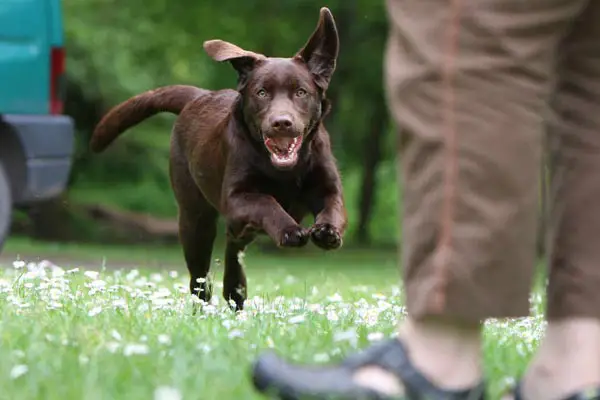Tips for Canoeing & Kayaking with a Dog in the US
Dive into the joy of canoeing and kayaking with your dog! Explore dog-friendly spots across the US, choose the right boat, and ensure a smooth ride with training tips.
Our guide covers essential gear, guaranteeing a safe and unforgettable adventure for you and your furry friend. Ready for a paddling experience like no other? Let’s make waves together! 🚣♂️🐾
Choose The Right Boat
The first step in canoeing and kayaking with a dog is to choose the right boat. Selecting a boat that can accommodate you and your dog comfortably and safely is essential. Many experts recommend a 14-foot kayak with an open cockpit or canoe with an open deck.
This allows your dog to sit or lie down between your legs and face forward. Avoid small cockpit kayaks that may not have enough space for larger dogs.
Additionally, consider the stability and maneuverability of the boat to ensure a smooth and enjoyable ride for you and your dog.
Table: Boat Options for Paddling with a Dog
| Boat Type | Advantages | Disadvantages |
|---|---|---|
| 14-foot open cockpit kayak | – Ample space for your dog to sit or lie down | – May require more effort to paddle due to size |
| Canoe with an open deck | – Easy for your dog to move around and find a comfortable spot | – Maybe less stable compared to a kayak |
| Small cockpit kayak | – Offers better control and maneuverability | – Limited space for larger dogs |
Training Your Dog Is Key
Teaching your dog water safety and commands for paddling will ensure a safe and enjoyable experience for both of you. Here are some training tips to prepare your dog for water activities:
Start with Basic Commands
- Train your dog to listen and respond to simple commands such as “sit,” “stay,” and “come.”
- Introduce commands specifically for paddling, like “get in your spot” or “lie down” to keep them in the designated area of the boat.
Familiarize Your Dog with the Water
- Gradually introduce your dog to the water by starting with shallow areas and slowly progressing to deeper sections.
- Allow them to explore and become comfortable with the kayak or canoe before going on the water.
Positive Reinforcement
- Reward your dog with treats and praise when they follow commands or exhibit positive behavior during training sessions.
- Use positive reinforcement techniques to create a positive association with water activities.
Don’t Forget Your Dog’s Life Jacket
Regarding paddling with your dog, safety should always be a top priority. Just like humans, dogs should wear a life jacket or personal flotation device (PFD) to ensure their safety on the water.
A dog life jacket is designed to provide buoyancy and support, keeping your furry companion afloat in case of unexpected accidents or fatigue.
Choosing the right dog life jacket is essential. Look for a well-fitted PFD suitable for your dog’s size and weight. It should have adjustable straps to ensure a snug and secure fit.
Opt for a bright-colored jacket to make your dog more visible in the water and add style to their attire.
Importance of Dog Life Jacket
The importance of a dog life jacket cannot be overstated. Even if your dog is a confident swimmer, unexpected situations can occur, leading to panic or exhaustion.
A life jacket provides an added layer of safety and peace of mind, allowing you to focus on enjoying your paddling trip without worrying about your dog’s well-being.
Additionally, a dog life jacket has a top handle, making lifting and carrying your dog in and out of the water easier. This is especially helpful during boarding and disembarking, ensuring a smooth transition for you and your canine companion.
| Benefits of a Dog Life Jacket | Considerations |
|---|---|
| Provides buoyancy and support | Choose a well-fitted jacket |
| Ensures safety in unexpected situations | Opt for a bright-colored PFD |
| Allows for easy lifting and carrying | Look for adjustable straps |
Safety Gear for Paddling with a Dog
In addition to a dog life jacket, other safety gear items are essential when paddling with your furry friend. Always remember to bring a leash to ensure you have control over your dog during stops or emergencies.
Additionally, consider packing a pet-specific first aid kit, including bandages, antiseptic wipes, and any necessary medications. Sunscreen is also essential to protect your dog from the sun’s harmful rays, especially on exposed areas like the nose or ears.
Packing Essentials for Canoeing and Kayaking with Your Dog
Here are some essential items to include in your dog’s pack:
- Food: Pack enough food for your trip, considering your dog’s nutritional needs. Store the food in an airtight container to keep it fresh and prevent attracting wildlife.
- Water: Hydration is critical, so provide adequate water for you and your dog. Consider using a collapsible bowl for easy access to water during breaks.
- Treats: Dog-friendly snacks can be a great way to reward your furry friend during the paddling adventure. Opt for treats that are easy to pack and won’t spoil.
Hydration Tips for Dogs on the Water
Here are some tips to keep your furry friend hydrated:
- Offer water regularly: Give your dog access to fresh water at regular intervals during breaks. Dogs can become dehydrated quickly, so encourage them to drink.
- Avoid natural water sources: While it may be tempting to let your dog drink from rivers or lakes, it’s best to bring clean water to prevent them from consuming potentially harmful bacteria or parasites.
- Watch for signs of dehydration: Watch for symptoms such as excessive panting, dry gums, and energy loss. If you notice any signs of dehydration, take a break and offer water immediately.
Transporting Dog Food on a Paddling Trip
Here are some tips:
- Choose compact and lightweight packaging: Opt for lightweight containers or resealable bags that won’t take up too much space in your kayak or canoe.
- Separate meals into individual portions: Pre-portion your dog’s food into smaller bags or containers for each meal, making it easier to feed them while on the water.
- Pack extra food: It’s always a good idea to pack extra food in case of unexpected delays or extended paddling trips. Be prepared for any situation.
Bring Along A First Aid Kit
Here are some canine first-aid supplies to include in your kit:
- Bandages and gauze
- Antiseptic wipes or solution
- Tweezers for removing splinters or ticks
- Scissors
- Tick remover tool
- Hydrogen peroxide (for cleaning wounds, if needed)
- Rectal thermometer
- Any necessary medications for your dog
In addition to first aid supplies, it’s also a good idea to pack sunscreen for your dog to protect them from the sun’s rays. Apply it to exposed areas such as their nose or ears to prevent sunburn. It’s important to note that not all human sunscreen is safe for dogs, so be sure to use sunscreen specifically formulated for pets.
| Canine First Aid Kit Essentials | Benefits |
|---|---|
| Bandages and gauze | Used to dress wounds and control bleeding |
| Antiseptic wipes or solution | To clean wounds and prevent infection |
| Tweezers | Used to remove splinters or ticks |
| Scissors | For cutting bandages or fur if necessary |
| Tick remover tool | To safely remove ticks from your dog |
| Hydrogen peroxide | For cleaning wounds, if advised by a veterinarian |
| Rectal thermometer | To monitor your dog’s temperature in case of illness or heatstroke |
| Any necessary medications | To address pre-existing health conditions |
Always Bring Doggie Bags
Responsible pet ownership extends to the water as well. When you’re out paddling with your dog, always bring doggie bags to dispose of their waste correctly. Not only is it a matter of cleanliness, but it also helps to protect the environment and maintain a positive experience for other paddlers.
Proper disposal of dog waste is crucial. If you’re in a remote area, bury the waste off to the side or follow local regulations for waste disposal. Some locations, particularly islands, may require you to carry out the waste. Be prepared with ziplock bags or a dedicated doggie trash can to avoid unpleasant odors or environmental impacts.
| Environmental Considerations for Dog Owners | Responsible Actions |
|---|---|
| Use biodegradable dog waste bags | Minimize plastic waste and promote eco-friendly waste disposal |
| Follow local regulations for waste disposal | Respect the rules of the area and help maintain a clean environment |
| Carry a doggie trash can | Ensure proper containment and avoid odor or pollution |
| Bury waste off to the side in remote areas | Prevent contamination and protect wildlife |
| Pack out waste on islands | Keep the island ecosystem clean and undisturbed |
Stay Safe If You Choose To Camp
Here are some essential tips and considerations to keep in mind when camping with your dog:
Safety Considerations for Camping with a Dog
Before setting up camp, thoroughly inspect the area for hazards such as broken glass or sharp objects that could harm your dog. Keep your dog on a leash to avoid wandering off or encountering wildlife. Using a bell on your dog’s collar during the day is also an excellent way to alert wildlife and minimize potential conflicts.
Dog-Friendly Camping Tips
Bring canine camping gear, such as a comfortable bed or cushion for your dog. Provide them with plenty of fresh water and food, and don’t forget to pack their favorite toys to keep them entertained. Consider creating a designated space within the campsite for your dog to relax and feel secure.
Camping Etiquette for Dog Owners
Respect other campers by adhering to proper camping etiquette. Keep your dog’s barking to a minimum and clean up after them promptly. Dispose of waste in designated areas or follow local regulations regarding waste disposal. By being a responsible dog owner, you can ensure a positive camping experience for both you and your fellow campers.
FAQ
What kind of boat should I choose for canoeing or kayaking with my dog?
Choosing a 14-foot kayak with an open cockpit or canoe with an open deck is recommended. This allows your dog to sit or lie down between your legs and face forward.
How should I train my dog for canoeing and kayaking?
Teach your dog basic commands such as “get in your spot,” “leave it,” and “lay down” to ensure they stay in the designated area of the boat. Introduce them to the water gradually and familiarize them with the kayak or canoe beforehand.
Should my dog wear a life jacket?
Yes, your dog should wear a life jacket or personal flotation device (PFD). Even if they are a confident swimmer, a life jacket adds an extra layer of safety in case of unexpected accidents or fatigue.
What essential supplies should I pack for my dog?
Pack enough food, doggie snacks, and water for your dog’s needs. Bring a collapsible bowl for water and offer regular hydration breaks during the trip.
Do I need a first aid kit for my dog?
Yes, always bring a first aid kit that includes items specifically for your dog’s needs. This should include bandages, antiseptic wipes, and any necessary medications.
How should I dispose of my dog’s waste on a paddling trip?
Always bring doggie poop bags to dispose of your dog’s waste properly. If in a remote area, bury the waste off to the side or follow local regulations for waste disposal. Some locations may require you to carry out the waste.
Are there any safety considerations for camping with my dog?
Check the campsite for potential hazards, bring something comfortable for your dog to sleep on, and keep them on a leash at night. Consider using a bell on their collar during the day to alert wildlife.



